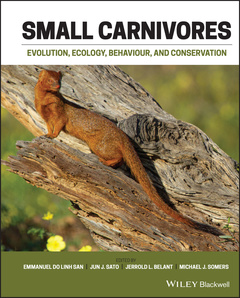Small Carnivores Evolution, Ecology, Behaviour and Conservation
Coordonnateurs : Do Linh San Emmanuel, Sato Jun J., Belant Jerrold L., Somers Michael J.

This book focuses on the 232 species of the mammalian Order Carnivora with an average body mass < 21.5 kg. Small carnivores inhabit virtually all of the Earth's ecosystems, adopting terrestrial, semi-fossorial, (semi-)arboreal or (semi-)aquatic lifestyles. They occupy multiple trophic levels and therefore play important roles in the regulation of ecosystems, such as natural pest control, seed dispersal and nutrient cycling. In areas where humans have extirpated large carnivores, small carnivores may become the dominant predators, which may increase their abundance ("mesopredator release") to the point that they can sometimes destabilize communities, drive local extirpations and reduce overall biodiversity. On the other hand, one third of the world's small carnivores are threatened or near threatened with extinction. This results from regionally burgeoning human populations' industrial and agricultural activities, causing habitat reduction, destruction, fragmentation and pollution. Overexploitation, persecution and the impacts of introduced predators, competitors, and pathogens have also negatively affected many small carnivore species. Although small carnivores have been intensively studied over the past decades, bibliometric studies showed that they have not received the same attention given to large carnivores. Furthermore, there is huge disparity in how research efforts on small carnivores have been distributed, with some species intensively studied and others superficially or not at all. This book aims at filling a gap in the scientific literature by elucidating the important roles of, and documenting the latest knowledge on, the world's small carnivores.
"This is a book that has been needed for decades. It is the first compendium of recent research on a group of mammals which has received almost no attention before the early 1970s. This book covers a wide range of subdisciplines and techniques and should be considered a solid baseline for further research on this little-known group of highly interesting mammals. As our knowledge regarding how ecosystems function increases, then the valuable role of small carnivores and the necessity for their conservation should be regarded as of paramount importance. The topics covered in this book should therefore be of great interest not only to academics and wildlife researchers, but also to the interested layman."
Professor Anne Rasa, Ethologist
Foreword
Reviewing process and reviewers
List of contributors
Part I: Introduction
Chapter 1 The World’s Small Carnivores Definitions, Richness, Distribution, Conservation Status, Ecological Roles, and Research Efforts
Part II: Evolution, Systematics and Distribution
Chapter 2 Molecular Systematics of the Caniform Carnivora and its Implications for Conservation
Chapter 3 Systematics and Evolution of the Mongooses (Herpestidae, Carnivora)
Chapter 4 Late Quaternary Biogeography of Small Carnivores in Europe
Chapter 5 Ecomorphological Disparity of Small Carnivore Guilds
Chapter 6 Beyond Black and White
Addressing Colour Variation in the Context of Local Environmental Conditions for the Aposematic American Hog-nosed Skunk
Part III: Ecology, Behaviour, and Diseases
Chaper 7 The function of Carnivore Latrines: Review, Case Studies, and a Research Framework for Hypothesis- Testing
Chaper 8 Factors Affecting European Badger Movement Lengths and Propensity: Evidence of Density-Dependent Effects?
Chapter 9 Behavioural Adaptations of Molina’s Hog-Nosed Skunk to the Conversion of Natural Grasslands into Croplands in the Argentine Pampas
Chapter 10 Activity and Movement Patterns of Urban Stone Martens
Chapter 11 A 9-Year Demographic and Health Survey of a European Mink Population in Navarre (Spain): Role of the Canine Distemper Virus
Chapter 12 Density of African Civets in a Moist Mountain Bushveld Region of South Africa
Part IV: Interspecific Interactions and Community Ecology
Chapter 13 Spatio-Temporal Overlap Between a Native and an Exotic Carnivore in Madagascar: Evidence of Spatial Exclusion
Chapter 14 Colonization of Agricultural Landscapes by the Pine Marten: Influence of Habitat Constraints and Interspecific Competition
Chapter 15 Spatial and Temporal Resource Partitioning of Small Carnivores in the African Rainforest: Implications for Conservation and Management
Chapter 16 Ecological Separation and Coexistence in a Carnivore Community in North-Central Thailand
Chapter 17 Interactions Between Honey Badgers and Other Predators in the Southern Kalahari: Intraguild Predation and Facilitation
Chapter 18 Seed Dispersal by Mesocarnivores Importance and Functional Uniqueness in a Changing World
Chapter 19 Ecology and Conservation of Southeast Asian Civets (Viverridae) and Mongooses (Herpestidae)
Part V: Interactions with People and Conservation
Chapter 20 Small Carnivore Introductions Ecological and Biological Correlates of Success
Chapter 21 Global Review of the Effects of Small Carnivores on Threatened Species
Chapter 22 The Global Consumptive Use of Small Carnivores Social, Cultural, Religious, Economic, and Subsistence Trends from Prehistoric to Modern Times
Chapter 23 Conservation Status of the North American River Otter in the United States and Canada Assessing Management Practices and Public Perceptions of the Species
Index
About the Editors
Emmanuel Do Linh San is an Associate Professor in the Department of Zoology and Entomology, University of Fort Hare, South Africa. He is the Founder and Director of African Small Carnivore Research Initiatives (ASCaRIs). He is currently an Associate Editor of African Journal of Wildlife Research, Mammal Study and Small Carnivore Conservation.
Jun J. Sato is a Professor in the Department of Biotechnology, Fukuyama University, Japan. He received Incentive Awards for Promising Young Researchers from the Mammal Society of Japan in 2012 and the Zoological Society of Japan in 2016. He is currently the Editor-in-Chief of Mammal Study.
Jerrold L. Belant is the Boone and Crockett Chair of Wildlife Conservation in the Department of Fisheries and Wildlife at Michigan State University, USA. He is a former Chair of the IUCN SSC Small Carnivore Specialist Group and Editor-in-Chief of Small Carnivore Conservation. He is currently on the Editorial Board of BioScience and Deputy Editor-in-Chief of Ursus.
Michael J. Somers is a Professor at the Mammal Research Institute, Department of Zoology and Entomology, University of Pretoria, South Africa. He is currently an Associate Editor of African Journal of Wildlife Research and Mammalian Biology, as well as a member of several IUCN SSC specialist groups.
Date de parution : 07-2022
Ouvrage de 624 p.
18.9x24.6 cm



